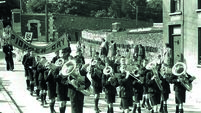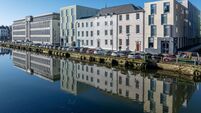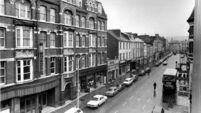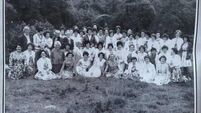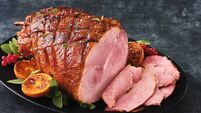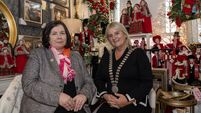Throwback Thursday: We strolled Pana... or took a horse and cart
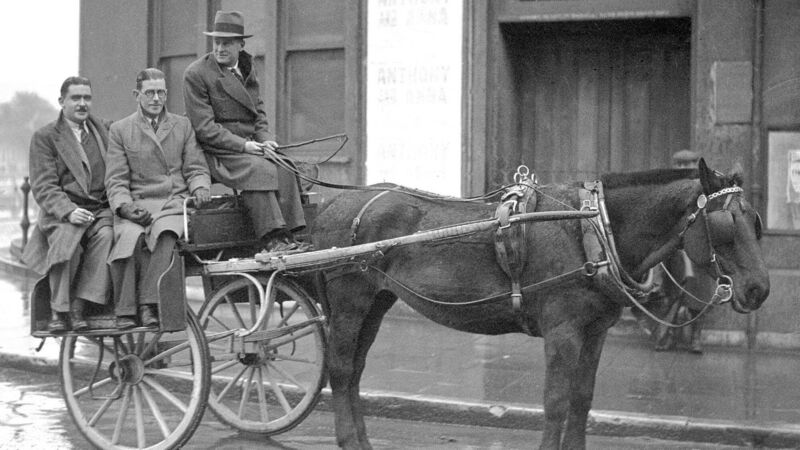
Local artistes Charlie Archer, Derry Fagan, and author Donal V. Giltinan in a horse and cart outside the Opera House in Cork in December, 1937 - they were set to perform a radio programme there that night
We got a lot of reaction to last week’s stories about old Cork and the hints and clues to yesteryear that you can still find in the streets and on the older buildings around the city.
When the Vikings decided that the Lee was a good site for one of their trading ports, they settled on the highest ground within the marshy delta, and so North and South Main Streets came into being.
By medieval times, they were busy thoroughfares, with narrow lanes - so narrow you would need to go sideways - between the houses and shops, leading down to the city walls.
At that time, a canalised branch of the river led up to this, almost on the direct line of modern day Castle Street, to Paradise Place. Most of the rest of what we know as the city today was still marsh and waterway.
Soon, the Grand Parade would come into being as a new and elegant place to wander and take the air. (We’re talking here of the high and mighty. The workers rarely got a chance to take the air, being too busy about their jobs.)
One place you can still see evidence of our old waterways is on the South Mall, where the merchants’ houses and stores fronted on to the quayside, with arched entrances to permit the arrival of boats laden with goods, and steps led up to living quarters on the higher floors.
And Le Chateau on Patrick Street had the same layout, with the water entrance below and steps leading up to the interior above.
Ever wonder how Drawbridge Street got its name? Or Bowling Green Street? Or Fenns Quay, with not a river in sight? Coach Street? It’s always worth noting and wondering, and doing a bit of research.
Once photography came in, of course, it provided superb visual information on what has since gone forever.
Horses and carts eventually gave way to trams, but bakeries and other industries still used these (as there wasnt really a transport alternative for goods).
This meant our streets needed cleaners constantly working with their brooms to clear mud and droppings so that ladies and gentlemen could cross in relative safety. (In fact, crinolined ladies habitually had lengths of coarse fabric sewn to the bottom of their skirts, which could be detached and washed when they got home. It was a very practical idea.)
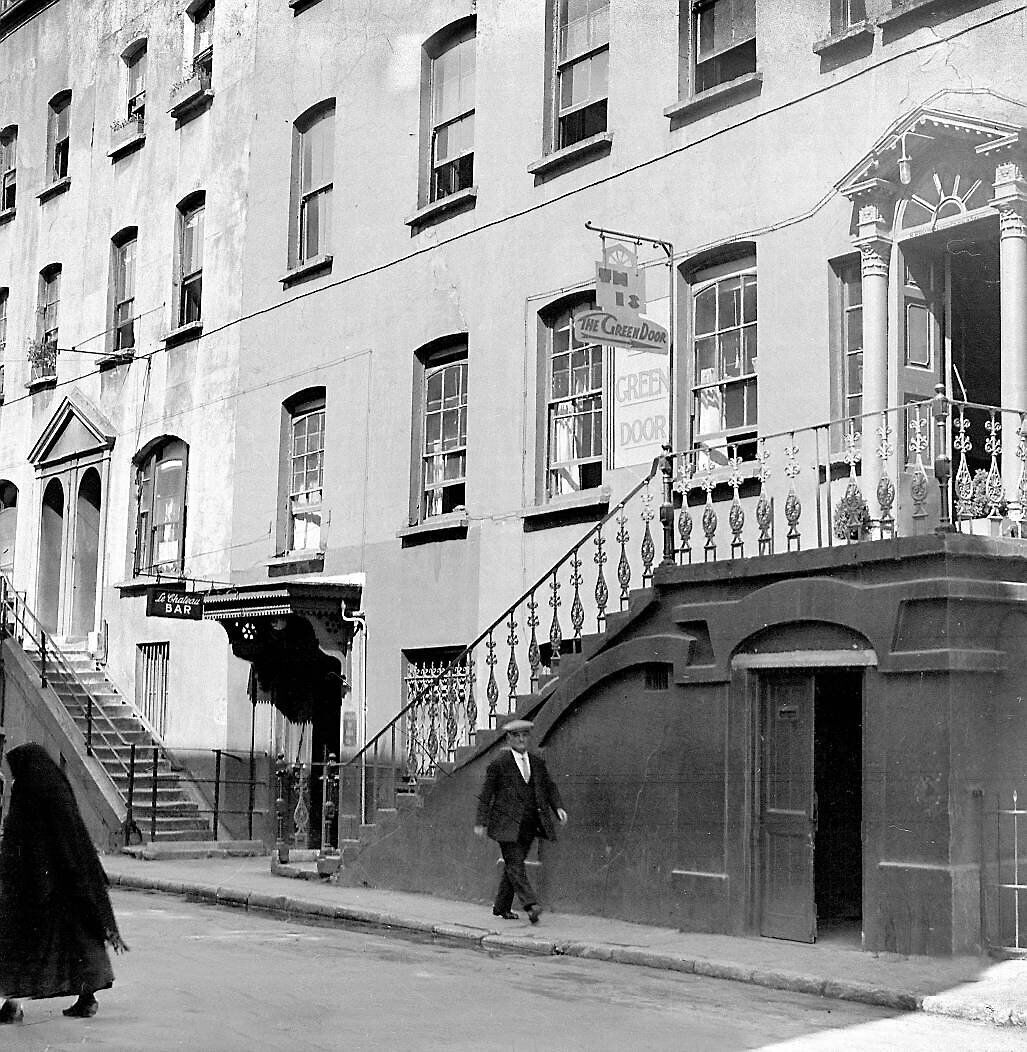
Later, the trams went too, and motor vehicles took over. It was the First World War really which pushed the spread of petrol engines. Lorries were much in demand behind the lines then, and once peace came, there were plenty of men (and probably women too) who knew how to work these infernal machines and were eager to set up companies and services using them.
Imagine the thrill of the first bus from a country village up to the city!
Even in the 1950s and ’60s, when cars were increasing steadily in number, it was commonplace to see the ponies and traps of country farmers tied up in Princes Street or surrounding back lanes when their owners came up to town to do their weekly marketing.
Certainly, many of the city bakers still used horse transport. Thompsons was still using those great Clydesdales right into the 1960s, while CIE kept them going even longer.
As you walked around the city then, the clip-clop of great feathery hooves was heard everywhere, the water troughs were kept filled for those thirsty muzzles, and the droppings manured many a city garden’s rose bushes!
To this, you could add the sound of the steam engine whistling and clanging its way from Kent Station to Albert Road, as Bob Roche observed last week. That’s all gone.
As often observed here on Throwback Thursday, we didnt know we were seeing history passing away at the time. You never do, do you?
Even since the ’50s and ’60s, our beloved city has changed a lot, hasn’t it?
What do you remember most about the streets you walked in your childhood, teenage years, or on your way to your first job?
The number of small individual shops would surely be up there in the memory banks, each one dealing with its own speciality, be it shoe repairs or some heavy stitching to your leather schoolbag, household supplies like Vim or carbolic soap, groceries, wines and spirits, shirt buttons, and knitting wool (there was a wonderful little shop on the corner of the Winthrop Arcade which dealt in all kinds of sewing, knitting, crochet supplies, patterns, transfers, etc, for housewives doing the weekly mending and girls learning the skills for later life.)
There were also food emporia where helpful assistants weighed out the sugar, sliced the bacon to the thinness of your exact liking, wrapped up the sausages, and found the tinned foods for which you had been searching.
Of course, it all took much longer than we expect today, when we load our own trolleys and check them out ourselves at a computer screen, but then that was part of the experience too. You talked with the shopkeepers, exchanged the news, and heard their views on things. And you talked to other shoppers too. Getting the messages done was a highly social event back then.
And we had big department stores too, like the Munster Arcade and Grants, both alas now gone.
They had high, polished counters that seemed lofty to young visitors clutching mother’s hand, and equally polished ladies and gentlemen who ascertained your mother’s needs and courteously supplied them.
Dresswear, men’s jackets, shoes, knitwear, fabrics, furniture, kitchen essentials... they had them all, and placed discreet advertisements in the Echo and Examiner to let Cork’s shoppers know that the latest stock of sandals or suits had just arrived.
Where was your favourite shop in those long-ago days? The HCC on MacCurtain Street, where you could buy little lead farm animals? Or Jack Healy’s close by, where the latest in shining new bicycles could be admired through the window?
The oh-so-tempting wide glass show window of The Lee Stores on the Grand Parade, right by the bus stop, so you could search with your eyes through the toys and games and dream of the joys therein just maybe for next Christmas ,while waiting for the No 8 to Mayfield?
Maybe a back street sweet shop where they would allow you to purchase just two ounces of bulls’ eyes or clove drops instead of the regulation quarter pound.
Any of the branches of Cudmores, where the heavy scent of fruit wafted out the door and made your mouth water.
Today, all these sweets and fruits are still available and many more that we hadn’t even heard of back then, but they are pre-packed, shrink-wrapped, to be taken from a display and brought to a machine for checkout, without one contact being made between seller and customer.
Is there still somewhere where you can see the bottle being taken down from the shelf, and your delectable desire being weighed carefully into the scales? I think there might be. Not as a survivor, but as a new development, to meet the modern wish for something a little more old-fashioned in style.
There are a few of those shops scattered now around the city, in side streets, handy for topping up on your way to the cinema or theatre.
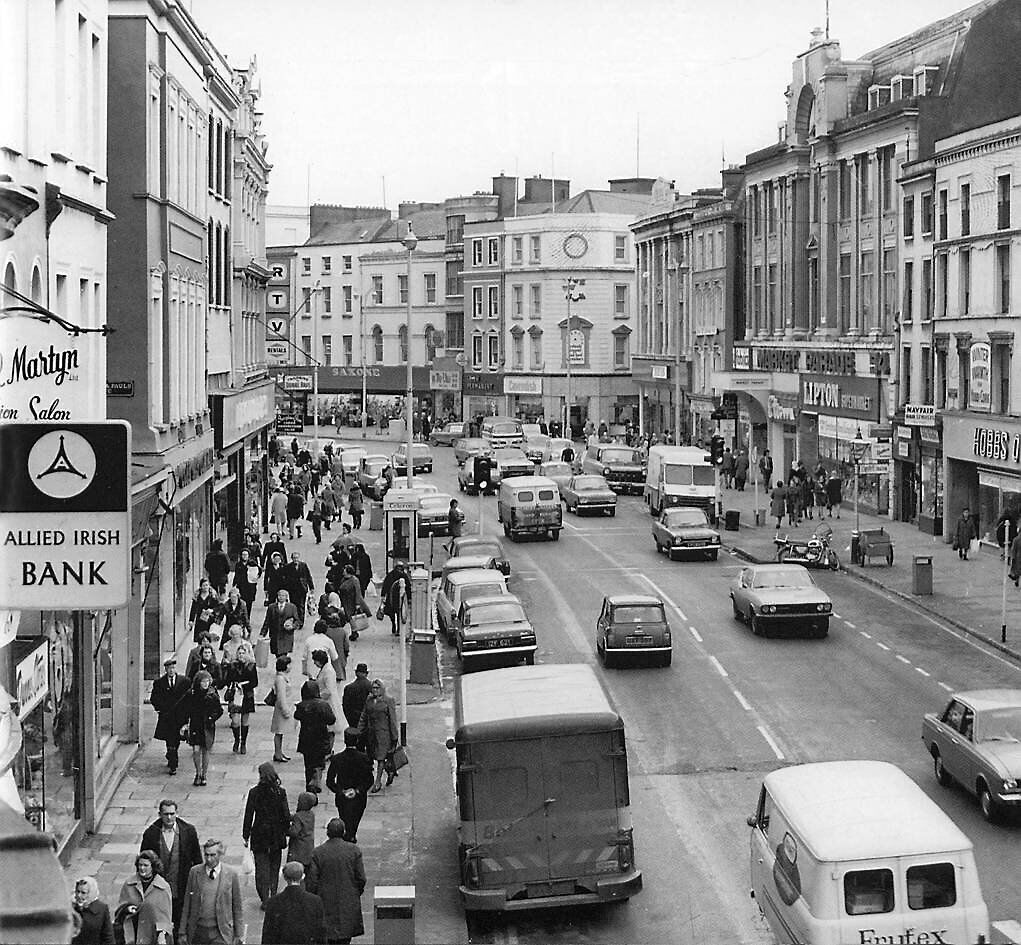
Ah the cinemas back then! We had so many of them, and knew the pluses and minuses, the good points and the bad of every single one.
The Savoy of course, was emperor of all, with ticket prices varying from luxury to survival, depending on your pocket. Plus that so-elegant restaurant upstairs with its hushed atmosphere and thick carpets muffling every footfall as the elite crossed through to the best seats.
The endless concrete stairs accessed from the side street for the gods.
And even if you weren’t going to the pictures, you might well have a half-definite date with someone on the steps outside, under that handy canopy which sheltered you from the rain.
The Pavilion, with that beautiful frontage and its own restaurant looking right out over Patrick Street, while the Savoy’s was always dark and discreet.
The Capitol on the Grand Parade. The Ritz on Washington Street, where they often showed foreign films with subtitles.
The Palace, both theatre and cinema in those days, Gilbert & Sullivan alternating with the latest horror movie or Western.
The little Lee on Winthrop Street... was there any truth in the rumour that at the back there were some double seats for young romance to blossom? Can somebody confirm that?
The Cameo up Military Hill was where advanced art films got a screening.
What ones have we left out? Gosh, mustn’t forget the Assembly Rooms, that relic of far earlier times, and of course the great old Lido in Blackpool, where up to the early 1960s you could still enjoy the folly-uppers, or part-series with a cliffhanger every week to make sure you came back for the next one.
And hold on, how about the Coliseum, where Summerhill and the Lower Road meet MacCurtain Street and Brian Boru Street? You could be sure of catching up with a few of the old western classics there.
You really got a full programme back then, with a starter, a documentary, maybe a cartoon or nature film, a preview of something coming up the following week, and then, finally, the big picture, when everybody settled down to be swept into another world for an hour or so.
What worlds those were, too! Incredibly glamorous mansions inhabited by Doris Day or Grace Kelly, dangerous bars frequented by Frank Sinatra or Marlon Brando, wide open desert spaces across which John Wayne or Jimmy Stuart galloped on horses that seemed as fresh at the end of the day as they were at the beginning.
We never thought of the actual filming, the work that went into those scenes. We just swallowed them wholesale and never doubted the truth of what we were seeing.
Didn’t we have a great outlook on the world from those films? And not just the films, the camaraderie of friends sharing the experience, the chat about it afterwards, the sayings and doings we avidly copied after seeing those stars?
What do you remember as having the greatest effect on you back then? And do you remember the matinees, the excitement, the anticipation; and later on, the going on a date to the flicks?
Then there was the traditional passegiata as the Italians would call it, the long, slow stroll down Pana on a Saturday afternoon, greeting and being greeted by so many of your friends who were also there for the formal yet casual wander.
It wasn’t so common back then to go in for a coffee; rather, you wandered down one side, then up the other, stopping to chat here and there, and generally catching up on all the latest news.
Doing Pana was an accepted social occasion, as important in Cork as a presentation at court would be in London.
That custom of doing Pana has all but disappeared too, as have all those shops and businesses which lined the street back then.
Heavens above, even the Examiner and Echo have shifted themselves from this central location down to furthest Blackpool, and while the Chateau Bar still exists, the Green Door café overhead is gone forever.
Tell us of the old Cork that you remember. Email jokerrigan1@gmail.com or leave a comment on our Facebook page, www.facebook.com/echolivecork.
